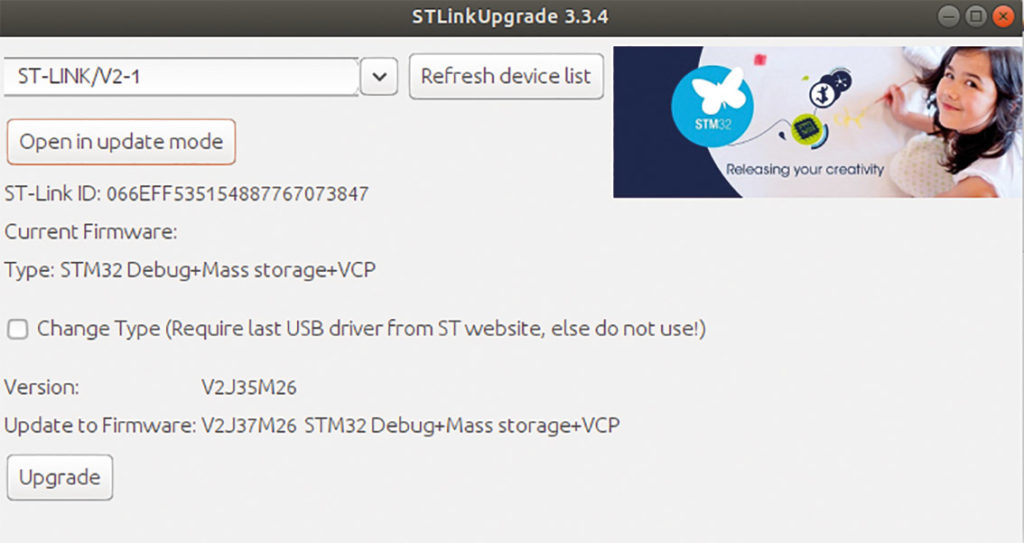
- #Nucleo f401re load firmware how to
- #Nucleo f401re load firmware install
- #Nucleo f401re load firmware full
- #Nucleo f401re load firmware software
- #Nucleo f401re load firmware Pc
#define MICROPY_HW_LED_OFF(pin) (pin->gpio->BSRRH = pin->pin_mask) #define MICROPY_HW_LED_ON(pin) (pin->gpio->BSRRL = pin->pin_mask) #define MICROPY_HW_LED_OTYPE (GPIO_MODE_OUTPUT_PP) #define MICROPY_HW_LED1 (pin_A5) // Green LD2 LED on Nucleo #define MICROPY_HW_USRSW_EXTI_MODE (GPIO_MODE_IT_FALLING) #define MICROPY_HW_USRSW_PULL (GPIO_NOPULL) Pressing the button makes the input go high. #define MICROPY_HW_UART6_PINS (GPIO_PIN_6 | GPIO_PIN_7) #define MICROPY_HW_UART2_PINS (GPIO_PIN_2 | GPIO_PIN_3) #define MICROPY_HW_CLK_PLLP (RCC_PLLP_DIV4) In the case of STM32NucleoF4 i used the following definitions: This file is essentially composed by #define directives, which enable and configure the stmhal for your specific board. The file mpconfigboard.h says to μPython more about the board capabilities. a file named stm32f4xx_hal_conf.h which contains the definition and import declarations for STM32Cube HAL (the one generated from STM32CubeMX tool should be sufficient).a file named pins.csv with the list of used pins (this depends on the hardware layout of your board).a file named mpconfigboard.mk containing link to Alternate Functions (AF) tables and GNU LD configuration script.a file named mpconfigboard.h containing directive which describes your board (more next).Create a subdir inside the stmhal/boards with the name of your board (in our case, STM32F4NUCLEO).To adapt μPython sources to a custom board, you need essentially these steps: For different architectures you have to play with μPython sources. Let's me clarify once again: the process I'm going to describe is for STM32 based boards.
#Nucleo f401re load firmware how to
How to adapt micropython to a different board The information I'll give can be really useful if you need to adapt μPython to a custom board based on STM32F4 platform.
#Nucleo f401re load firmware full
But if you are interested to the full story, you can continue reading this tutorial. This is mainly thanks to the excellent work done from the μPython community. First of all, start cloning my micropython repo form github inside the ~/STM32Toolchain directory:Īs you can see, it is really simple to port μPython to a Nucleo-F4 board. At the end of this procedure you'll be able to run the classical Python interactive console (also know as read–eval–print loop (REPL)) and start having fun with it.
#Nucleo f401re load firmware install
if you need to install a complete GCC/Toolchain, you can follow this guide.you are free to use a different path, but arrange my instructions accordingly.You have a fully working GCC toolchain installed in ~/STM32Toolchain/gcc-toolchain.
#Nucleo f401re load firmware Pc

In this post I'll show you how to successfully compile μPython for the Nucleo-F401RE board, the one I've already used in my past tutorials. The μPython project has also successfully raised for founds on kickstarter for two electronic boards: the PyBoard, a really simple prototyping board based on the STM32F4 family, and WiPy based on the CC3200 Wi-Fi chip from TI.īeing the PyBoard based on the STM32F4 family of MCU, and the HAL provided by ST, it's quite simple to adapt μPython to other boards with the same MCU, even to custom designed board. μPython is not a simple one-to-one port of Python, but it's a complex effort to adapt the official CPython to hardware architectures with really low physical resources (especially RAM). Micropython is a really impressive effort from Damien George (and the community) to port Python 3.x to low cost MCU. For example, the STM32 platform is a really cost effective family of MCU considering the feature it implements.īut things are changing. Due to its nature of high level and interpreted programming language, Python is still not present on true embedded microcontrollers, even if they are becoming always more powerful.
#Nucleo f401re load firmware software
I wrote hundreds of thousands lines of code in Python, ranging from web apps to software running on embedded single board computers like the Raspberry PI.

Everyone who knows me is also aware of the fact that my favorite programming language is Python.


 0 kommentar(er)
0 kommentar(er)
